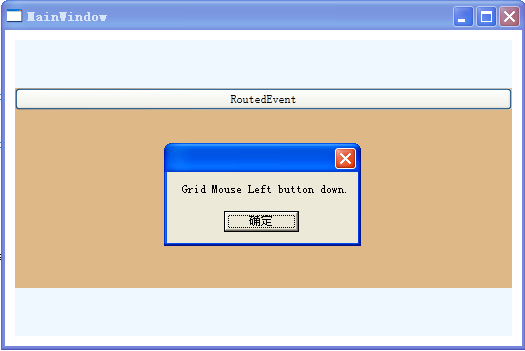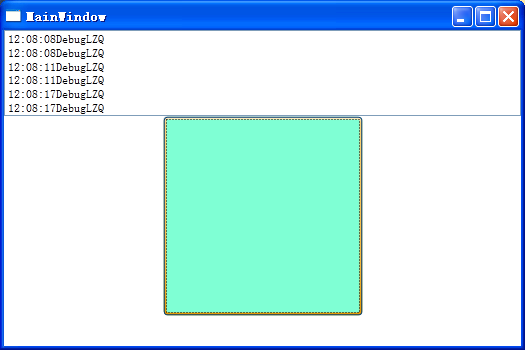WPF 自定义路由事件
WPF中的路由事件 as U know,和以前Windows消息事件区别不再多讲,这篇博文中,将首先回顾下WPF内置的路由事件的用法,然后在此基础上自定义一个路由事件。
1.WPF内置路由事件
WPF中的大多数事件都是路由事件,WPF有3中路由策略:

具体不多讲,单需要注意的是WPF路由事件是沿着VIsualTree传递的。VisualTree与LogicalTree的区别在于:LogicalTree的叶子节点是构成用户界面的控件(xaml紧密相关),而VisualTree要连控件中的细微结构也算上。VisualTree是LogicalTree的扩展。
reference: Understanding the Visual Tree and Logical Tree in WPF
下面给出一个使用WPF内置路由事件的例子:
<Window x:Class="WPFRoutedEvent.MainWindow" xmlns="http://schemas.microsoft.com/winfx/2006/xaml/presentation" xmlns:x="http://schemas.microsoft.com/winfx/2006/xaml" Title="MainWindow" Height="350" Width="525" > <Grid x:Name="Grid1" Margin="10" Background="AliceBlue" MouseLeftButtonDown="Grid1_MouseLeftButtonDown"> <StackPanel Background="BurlyWood" Height="200" x:Name="StackPanel1" Button.Click="ButtonInStackPanel_Click" MouseLeftButtonDown="StackPanel1_MouseLeftButtonDown"> <Button x:Name="Button1" Content="RoutedEvent" Click="Button1_Click" /> </StackPanel> </Grid> </Window>
 View Code
View Code
using System.Windows; using System.Windows.Controls; using System.Windows.Input; namespace WPFRoutedEvent { /// <summary> /// MainWindow.xaml 的交互逻辑 /// </summary> public partial class MainWindow : Window { public MainWindow() { InitializeComponent(); //Grid订阅Button的Click事件 Grid1.AddHandler(Button.ClickEvent, new RoutedEventHandler(ButtonInGrid_Click)); } private void Button1_Click(object sender, RoutedEventArgs e) { MessageBox.Show("Button Clicked."); // //e.Handled = true; } private void ButtonInStackPanel_Click(object sender, RoutedEventArgs e) { MessageBox.Show("StackPanel Clicked."); } private void ButtonInGrid_Click(object sender, RoutedEventArgs e) { MessageBox.Show("Grid Clicked."); } private void Grid1_MouseLeftButtonDown(object sender, MouseButtonEventArgs e) { MessageBox.Show("Grid Mouse Left button down."); } private void StackPanel1_MouseLeftButtonDown(object sender, MouseButtonEventArgs e) { MessageBox.Show("StackPanel Mouse Left button down."); } } }
Button的Click事件是一个路由事件,分别在StackPanel中和Grid中订阅这个事件并进行相应的处理,分别用xaml代码和C#代码如下:
Click="Button1_Click"
Button.Click="ButtonInStackPanel_Click"
Grid1.AddHandler(Button.ClickEvent, new RoutedEventHandler(ButtonInGrid_Click));
StackPanel的MouseLeftButtonDown也是一个路由事件,也可以叫“附加事件”。其实“附加事件”也是路由事件,只是个文字游戏,为什么还要另外起个名字呢?原来路由事件的宿主都是那些拥有可视化实体的界面元素;而附加事件则不具备显示在用户界面上的能力。
常见的附加事件有:
Binding类:SourceUpdated事件、TargetUpdated事件。
Mouse类:MouseEnter事件、MouseLeave事件、MouseDown事件、MouseUp事件等。
Keyboard类:KeyDown事件、KeyUp事件等。
Grid和StackPanel中均如下订阅:
MouseLeftButtonDown="StackPanel1_MouseLeftButtonDown"
程序运行如下:

2.自定义路由事件
前面DebugLZQ写过一篇博文,内容是关于自定义CLR事件的,参考:.NET自定义事件小结。下面来自定义一个WPF路由事件,各位博友可以比较下两者的异同。
创建自定义路由事件大体可以分为三个步骤:
(1)声明并注册路由事件
(2)为路由事件添加CLR事件包装
(3)创建可以激发路由事件的方法
下面我们自定义一个WPF路由事件,我们给事件携带个参数,为此需要创建一个RoutedEventArgs类的派生类。如下:
using System; using System.Windows; namespace MyRoutedEvent { //事件参数 class ReportTimeRoutedEventArgs:RoutedEventArgs { public ReportTimeRoutedEventArgs(RoutedEvent routedEvent, object source) : base(routedEvent, source) { } public DateTime ClickTime { get; set; } } }
然后,创建一个Button类的派生类并按前面的步骤为其添加路由事件:
using System; using System.Windows.Controls; using System.Windows; namespace MyRoutedEvent { class TimeButton:Button { //声明和注册路由事件\ public static readonly RoutedEvent ReportTimeRoutedEvent = EventManager.RegisterRoutedEvent("ReportTime", RoutingStrategy.Bubble, typeof(EventHandler<ReportTimeRoutedEventArgs>), typeof(TimeButton)); //CLR事件包装 public event RoutedEventHandler ReportTime { add { this.AddHandler(ReportTimeRoutedEvent, value); } remove { this.RemoveHandler(ReportTimeRoutedEvent, value); } } //激发路由事件,借用Click事件的激发方法 protected override void OnClick() { base.OnClick();//保证Button原有功能正常使用,Click事件被激发 ReportTimeRoutedEventArgs args = new ReportTimeRoutedEventArgs(ReportTimeRoutedEvent, this); args.ClickTime = DateTime.Now; this.RaiseEvent(args);//UIElement及其派生类 } } }
下面是程序界面的XAML代码,看下如何消费这个路由事件:
<Window x:Class="MyRoutedEvent.MainWindow" xmlns="http://schemas.microsoft.com/winfx/2006/xaml/presentation" xmlns:x="http://schemas.microsoft.com/winfx/2006/xaml" xmlns:local="clr-namespace:MyRoutedEvent" Title="MainWindow" Height="350" Width="525"> <Grid x:Name="grid1" local:TimeButton.ReportTime="TimeButton_ReportTime"><!----> <Grid x:Name="grid2"> <Grid x:Name="grid3"> <StackPanel x:Name="stackPanel1"> <ListBox x:Name="listBox1"/> <local:TimeButton Width="200" Height="200" Background="Aquamarine" ReportTime="TimeButton_ReportTime" /><!----> </StackPanel> </Grid> </Grid> </Grid> </Window>
事件处理的后台代码如下:
using System.Windows; namespace MyRoutedEvent { /// <summary> /// MainWindow.xaml 的交互逻辑 /// </summary> public partial class MainWindow : Window { public MainWindow() { InitializeComponent(); } private void TimeButton_ReportTime(object sender, ReportTimeRoutedEventArgs e)//注意参数 { listBox1.Items.Add(e.ClickTime.ToLongTimeString()+"DebugLZQ"); } } }
程序运行效果如下:

小结:UIElement类是路由事件和附加事件的分水岭,因为从UIElement类开始才具备了再界面上显示的能力,也因为RaiseEvent、AddHandler和RemoveHandler这些方法也定义在UIElement类中。附加事件也只能算是路由事件的一种用法而不是一个新的概念,其本质还是路由事件。
